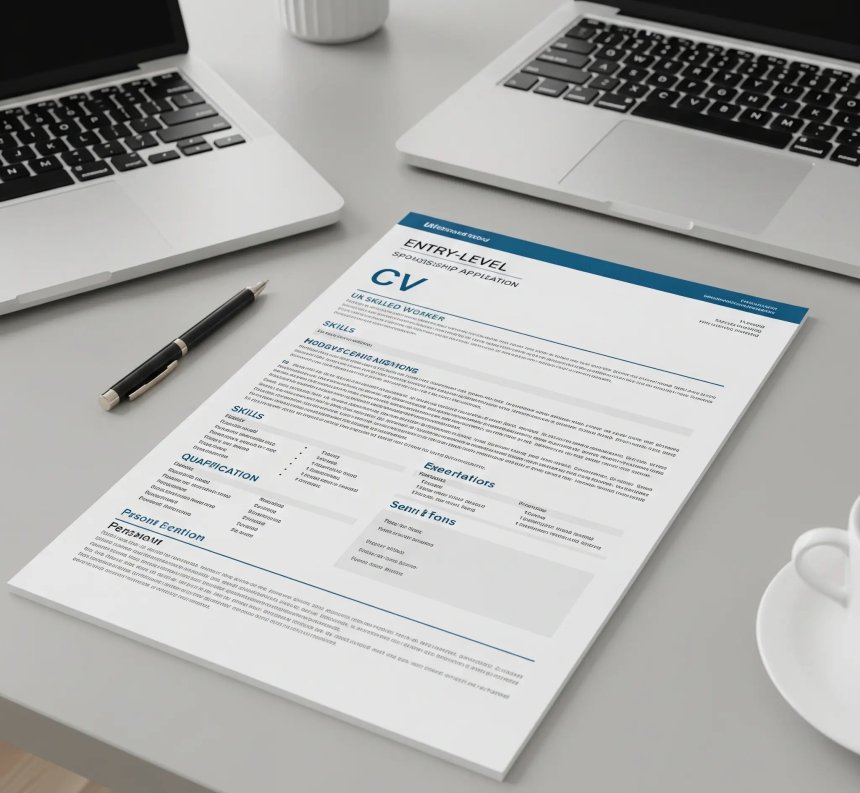Entry-Level Tech CV for UK Skilled Worker Visa | Sponsorship Guide
This guide provides a comprehensive overview for individuals crafting an entry-level tech CV specifically aimed at securing roles in the UK with Skilled Worker Visa sponsorship. It will cover key elements such as formatting, essential sections, how to highlight relevant skills and projects (even without extensive experience), and tailoring your CV to meet the requirements of UK employers and visa regulations, ultimately helping you stand out to potential sponsors.

Securing a Skilled Worker visa sponsorship for an entry-level tech role in the UK requires both a well-crafted CV and a strong performance in the interview. UK tech employers are willing to sponsor international talent – nearly 54,000 international tech workers relocated to the UK in 2022, a number that has risen each year since 2017. However, competition is high, and immigration rules are evolving. This guide offers comprehensive advice on tailoring your CV and interview approach to enhance your chances of securing a sponsorship-backed job offer. We include real examples (from both international and UK graduates), sample CV bullet points, insights on in-demand skills, and strategies to align your profile with Skilled Worker visa requirements.
Tailoring Your CV for UK Sponsorship Opportunities
A CV aimed at UK employers must meet British standards in terms of format and content, while also indicating your visa requirements. Key tips include:
- Follow UK CV Conventions: Keep your CV concise (no more than two pages) and use a clean, professional layout. Use British English spelling and grammar consistently, and refrain from including unnecessary personal details, such as your photo, age, marital status, or religion. UK recruiters prefer a focus on skills and experience without personal identifiers that could invite bias. For example, unlike some countries’ resumes, a UK CV never includes a headshot or date of birth.
- Structured Sections: Organise your CV into clear sections: Contact Information, Personal Profile, Skills, Work Experience, Education, and optionally Projects or Certifications. At the top, list your name and contact details (phone, email, UK address, and LinkedIn URL). Do not list nationality or visa status here – instead, address visa status in a dedicated section (explained below). Follow with a brief personal profile (2–3 sentence summary highlighting your academic background and key skills or goals). Then detail your work experience and projects in reverse chronological order, followed by your education and any relevant certifications. Use clearly labelled headings and bullet points so a busy recruiter can scan.
- Emphasise Relevant Tech Skills: Create a focused Skills section to highlight both technical competencies and soft skills relevant to the target role. Tailor this to each application by including keywords from the job description. For example, if applying to a software developer role, list programming languages (Python, Java, etc.), cloud platforms, or frameworks mentioned in the posting. Also mention sought-after soft skills – e.g. teamwork, problem-solving, adaptability – which UK employers highly value alongside technical ability.
Tip: Group skills by category (e.g. “Programming Languages: Java, Python; Tools: AWS, Docker; Soft Skills: Agile collaboration, communication”). This helps Applicant Tracking Systems and human readers quickly spot your qualifications. - Show Impact with Achievements: Under each work experience or project, use bullet points to describe your accomplishments – not just duties – and quantify results wherever possible. UK recruiters respond well to numbers and concrete outcomes. For example, instead of saying “Worked on a web application,” say “Developed a web application in React used by 5,000+ users, improving page load times by 30%”. Each role entry should include 2–3 achievement bullets demonstrating impact. Use action verbs (“developed, improved, led, increased”) and the STAR method (Situation, Task, Action, Result) implicitly to give context. (See next section for sample bullet points.)
- Include UK-Relevant Certifications: Bolster your CV with any globally recognised certifications or awards in your field. Certifications demonstrate verified skills and a commitment to professional development – traits that UK employers value. For instance, a cloud engineer might list “AWS Certified Solutions Architect”, or a data analyst could list an industry course in data visualisation. However, prioritise quality over quantity – a few relevant certs (or online courses) that align with the job are better than a long list of unrelated credentials. If English is not your first language and you’ve passed an English proficiency test (e.g., IELTS), you don’t need to list the score on your CV; your degree or test certificate will be considered during the visa stage. Instead, demonstrate language proficiency through a well-written, error-free CV (have a native speaker review it).
- Demonstrate Interest in the UK Market: Subtly show you’ve done your homework on UK tech trends. You may reference a relevant UK project or regulation, if applicable (e.g., mention experience with GDPR compliance if applying for data roles, as UK/EU data privacy is a key consideration). This isn’t mandatory, but it can signal that you understand the context of the UK industry. Additionally, if you have experience working with multicultural teams or clients from the UK/European clients, highlight this to demonstrate your cultural adaptability.
- “Right to Work” Section (Visa Status): At the end of your CV, include a brief section clarifying your work authorisation status. This is crucial for international candidates seeking sponsorship. Be transparent about the need for visa sponsorship, but frame it positively. For example, you could write:
Right to Work: Eligible to work full-time in the UK with Skilled Worker visa sponsorship (visa sponsorship required; no work restrictions otherwise).
If you are already in the UK on a post-study Graduate Visa (which allows work without sponsorship for 2 years), mention that: “Currently on Graduate Route visa (expires Nov 2025); will require Skilled Worker sponsorship thereafter.” The key is to assure employers you understand the process and meet the criteria. As one career consultant notes, “You must include your visa status on your CV and be upfront about it”. Hiding the need for sponsorship is a serious faux pas – employers may feel misled if it comes up late. By stating it clearly (typically as one line at the bottom of the CV or in your cover letter), you show honesty and that you’ve researched the visa pathway. Many UK tech companies are open to sponsoring graduates, but they need to know your situation from the start.
- Adapt for ATS: Ensure your CV is ATS-friendly since UK employers often use Applicant Tracking Systems to screen CVs. Use standard section headings (Education, Skills, Experience), simple fonts, and avoid tables or graphics that parsing algorithms might skip. Save as PDF with text (not scanned images). Include relevant keywords naturally in your text (such as technical terms, job titles, and programming languages) so the ATS flags you as a match. For example, if a job posting mentions “machine learning,” make sure that exact phrase (if relevant to your background) appears in your CV. Little details like using “Programme” instead of “Program” (British spelling) can also signal your attentiveness to UK norms.
Following these CV tailoring tips will help you present yourself as a highly qualified, visa-ready candidate. In the next section, we illustrate what strong CV bullet points look like for entry-level tech roles.
Sample CV Highlights: Skills, Achievements, and Projects
Crafting effective bullet points on your CV can significantly boost your appeal to UK tech employers. Below are sample CV bullet points (for a hypothetical entry-level software graduate) that demonstrate skills, achievements, and project experience in a way that would attract sponsorship-minded employers:
- Developed a full-stack web application using React and Node.js for a university project, serving 2,000+ users and reducing page load time by 30% through code optimisation. (Technical achievement showing impact in numbers)
- Automated data analysis processes with Python (Pandas) and SQL at an internship, which cut report generation time by 50% and improved accuracy, supporting data-driven decisions for the team. (Shows technical skill + quantifiable result)
- Led a team of 4 in an Agile capstone project to build a mobile app, implementing CI/CD pipelines (GitHub Actions) and delivering 2 weeks ahead of deadline. Earned top project grade and commendation from faculty for teamwork. (Demonstrates leadership, project management, and a successful outcome)
- Collaborated with cross-functional teams (developers, designers, and clients) as a student consultant to develop an e-commerce prototype, earning client sign-off after presenting a polished MVP demo. (Highlights communication and teamwork skills in an English-speaking environment)
- Certification: AWS Certified Cloud Practitioner – Achieved 2024. (A concise bullet under a “Certifications” or “Training” sub-section, showing a UK-relevant tech credential to strengthen profile)
Each of these bullets follows best practices: they start with a strong action verb, highlight a relevant skill area, and end with a concrete achievement or outcome. When writing yours, ask “What was the benefit or result of my work?” and try to include that. UK employers appreciate candidates who demonstrate impact and initiative, even at graduate level.
Also, notice the tone: confident but factual, with no exaggeration. Ensure any claims you make can be defended in an interview (e.g. be ready to explain how you measured “30% faster” or your role in a team project). These kinds of bullet points not only make your CV stand out, but they also provide great talking points for interviews, giving you a chance to elaborate on your experience.
Share
What's Your Reaction?
 Like
0
Like
0
 Dislike
0
Dislike
0
 Love
0
Love
0
 Funny
0
Funny
0
 Angry
0
Angry
0
 Sad
0
Sad
0
 Wow
0
Wow
0













